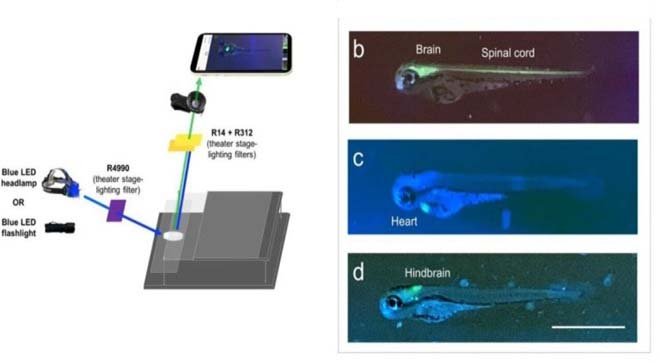FLUORESCENCE MISCROSCOPY

WHY IN NEWS?
- Recently, researchers at the Winona State University, Minnesota, have created a design for a ‘glowscope’.
WHAT IS GLOWSCOPE?
- It is a device that could democratise the access to fluorescence microscopy.
- Glowscopes may be suitable for some research applications.
- Its development was to meet the needs of science educators and outreach programs.
WHAT IS FLUORESCENCE MICROSCOPY?
- It is an optical microscope that views an object by studying how it absorbs, reflects or scatters visible light.
- A fluorescence microscope views an object by studying how it re-emits light that it has absorbed, i.e. how it fluoresces.
- There are versions of fluorescent microscopes with more sophisticated abilities, such as epifluorescence and confocal laser-scanning microscopes.
- Fluorescence microscopes range in cost from several thousand to several hundred thousand US dollars.
FUNCTIONING OF FLUORESCENCE MICROSCOPY
- The object is illuminated with light of a specific wavelength.
- Particles in the object absorb this light and reemit it at a higher wavelength (i.e. different colour).
- These particles are called fluorophores.
- When the fluorophores fluoresce, a fluorescent microscope can track them as they move inside the object, revealing the object’s internal shape and other characteristics.
USE OF FLUORESCENCE MICROSCOPY IN BIOTECHNOLOGY
- A fluorophore called the Hoechst stain binds to the DNA and is excited by ultraviolet light.
- So, a tissue sample collected from a person could be injected with the Hoechst stain and placed under a fluorescent microscope.
- When the sample is illuminated by ultraviolet light, the stain absorbs the light and reemits it at a higher wavelength.
- The microscope will point out where this is happening: in the nuclei of cells, where DNA is located.
- This way, the nuclei in the tissue can be labelled for further study.
- Scientists have developed different fluorophores to identify and study different entities, from specific parts of the DNA to protein complexes.
BENEFITS OF GLOWSCOPE
- The researchers were able to image the creatures’ brain, spinal cord (using a fluorophore called DsRed), heart (mCherry), and head and jaw bones (mRFP).

- They were able to zoom in and out using the smartphone camera and the clip-on lens, and by adjusting the distance between the sample and the smartphone platforms.
- To detect green and red fluorophores and to monitor and detect changes to heart rate and rhythmicity in embryonic zebrafish.
FUNCTIONING OF GLOWSCOPES

- Their setup consists of two plexiglass surfaces, an LED flashlight, three theatre stage-lighting filters, a clip-on macro lens, and a smartphone.
- The smartphone (with the lens attached) is placed on one surface that is suspended at a height (say, a foot above).
- The second sheet is placed below and holds the object.
- One of the stage-lighting filters was held between the flashlight and the object and the other two were held between the object and the smartphone.

- The role of these filters was to ensure that light of the right frequency reached the object and that fluoresced light of a suitable frequency reached the camera.
CHALLENGES IN THE USE OF GLOWSCOPE
- The total estimated cost of setup used to obtain these microscopes range in cost from several thousand to several hundred thousand US dollars.
- Such huge cost can prevent many individuals in India to get access to latest technological interventions.
- Using a ‘glowscope’ still requires access to fluorophores, suitable biological samples, the knowhow to combine the two, and some knowledge of physics to work out which LED flashlight to buy.
WAY FORWARD
- Instead of being entirely out of reach, researchers can prepare samples from fluorescent microscope, which can be set up with a few thousand rupees and then take them to schools where students can observe them using glowscope.
- The Foldscope was truly remarkable because all its required components were simple to understand.
- Researchers and students in resource poor labs can also use foldscopes and ‘glowscopes’ together to learn more about the microscopic affairs.
SOURCE : THE HINDU
SYLLABUS : MAINS, GS-3, SCIENCE&TECHNOLOGY


